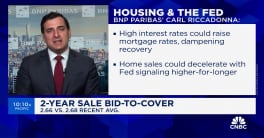It appears that many at the Treasury Department are keeping their fingers crossed as December 31 approaches.
That is the date by which a large number - nearly 375,000 - of loan modifications will have completed the three-month trial period required under the Home Affordable Modification Program (HAMP) designed to keep homeowners out of foreclosure. No one appears to know at this point how many homeowners will actually be able to transition from the trial into a permanently restructured loan.
This information was presented today by Treasury Assistant Secretary for Financial Stability Herbert Allison in a written report to the House Financial Services Committee.
Allison told the Committee that "we are disappointed in the permanent modification results thus far," and said that "we need to do better at converting borrowers to permanent modifications."
Over 900,000 troubled homeowners have received offers to begin trial modifications but Allison described the numbers which have successfully converted into permanent modifications as "thousands." He said that the large majority of those in trial programs are current on their payments but have some of the required documentation missing from their applications for permanent status. "Housing counselors and homeowners report that servicers are losing documents, while services are not providing documents despite repeated outreach."
The Assistant Secretary said that Treasury last week kicked off a "Mortgage Modification Conversion Drive" to increase the rate of permanent modifications. Among the steps planned are:
- Streamlining the application process with standardized paperwork to make it easier for both borrowers and servicers to complete and evaluate the application.
- Publishing servicer-specific conversions rates starting with the next public report.
- Punitive measures against servicers including withholding incentive payments.
- Increased communication with servicers including a meeting last Monday focused on conversion issues.
- Requiring each servicer to report twice daily on conversion progress.
- Forming SWAT teams made up of Treasury and Fannie Mae staff to visit the seven largest servicers to work on conversion issues.
- New tools for borrowers. These are available on the Department's website and include an instructional video, links to required documents, and a conversion guide.
- Outreach to local organizations to enlist their assistance in helping borrowers through the process.
Despite the problems with conversions, Allison said that strong progress had been made in ramping up the HAMP program with over 680,000 borrowers now in modifications. These homeowners are already seeing monthly savings that average $550.
The Treasury Department hopes that the HAMP program will eventually provide assistance to 3 to 4 million homeowners. While the conversions are a worry, the trial programs are on-track to meet that goal with over 20,000 borrowers now entering a trial each week.
He said that other aspects of Administration efforts to stabilize the housing market are also paying off. Continued support for Fannie Mae, Freddie Mac and Treasury's Mortgage Backed Securities (MBS) purchase program along with the Fed's purchase of MBS have helped keep interest rates near all-time lows. This has allowed over 3 million people to refinance. Treasury is now working to provide increased access to financing for local housing agencies. He also credited contributions by the home buyers' tax credit and two Treasury sponsored programs designed to shore up the rental housing sector.
There are, he said, signs of stabilization in housing. In addition to low interest rates and high numbers of refinances, housing inventories are continuing to fall and house prices are not dropping as rapidly as in the past with some house price measures actually posting increases in recent months.
While MND's managing editor, Adam Quinones, does agree that the housing market has stabilized from anemic activity levels, he remains skeptical of a recovery: "Ignoring the laundry list of issues one could present as an argument against housing expansion, the simple combination of two structural inefficiences: tighter lending guidelines -- DU 8.0 and new FHA initiatives for example-- and a stagnate labor market, creates a dynamic that will prohibit notable progress in the housing recovery process."







